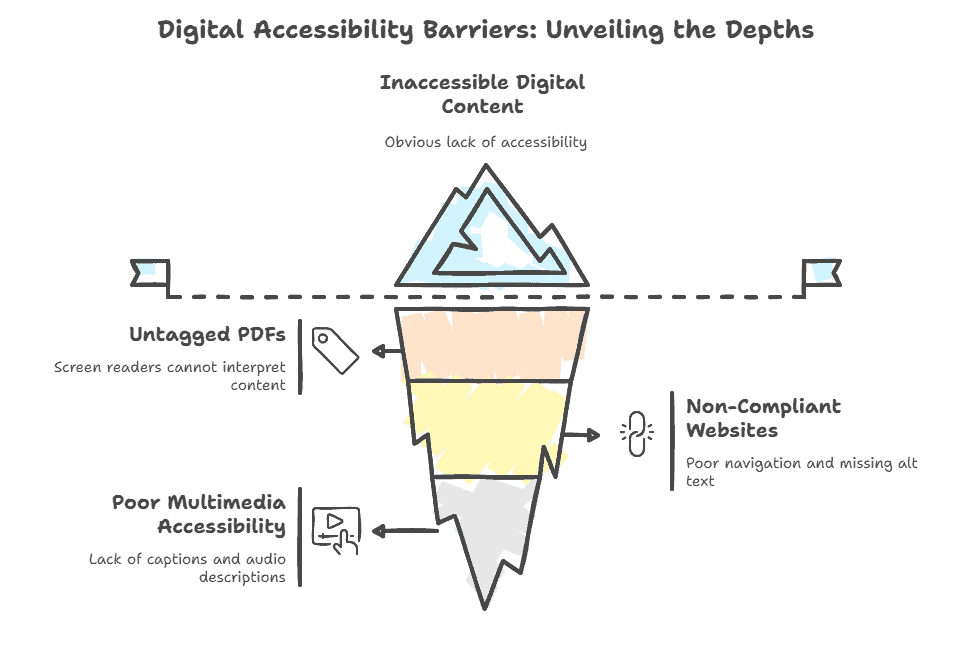Section 508 compliance is a critical requirement for federal agencies and businesses in the US that work with the government, ensuring that electronic and information technology is accessible to people with disabilities. Understanding these regulations helps organizations meet legal obligations and improve usability for all users.
What Section 508 Is and Who It Applies To
Section 508 of the Rehabilitation Act is a federal law that requires electronic and information technology developed, procured, maintained, or used by federal agencies to be accessible to people with disabilities. Enacted to eliminate barriers in information technology, Section 508 ensures that all users, regardless of ability, have equal access to digital content and services. This law promotes digital accessibility within government operations and beyond.
While aimed mainly at federal agencies, these regulations also apply to contractors and businesses supplying goods or services to the federal government. These entities must ensure that their electronic content and technology comply with Section 508 standards. Additionally, many state and local governments, as well as private organizations, voluntarily adopt Section 508 requirements to align with best practices in accessibility and to meet growing expectations for inclusive digital experiences.

Why Section 508 Compliance Matters
Section 508 compliance is more than a regulatory requirement. It is a foundation for accessible, inclusive, and responsible digital practices. Meeting these standards protects organizations from legal and contractual risks, strengthens usability for people of all abilities, and safeguards reputation. Understanding why compliance matters highlights both the obligations and the opportunities it creates.
Legal and Contractual Obligations
Compliance with Section 508 is a legal requirement for federal agencies and contractors. Failure to meet these standards can result in contract delays, penalties, and legal challenges. For businesses working with the government, non-compliance may jeopardize contracts or future opportunities. Meeting Section 508 requirements helps organizations fulfill their contractual obligations and avoid legal consequences.
Enhancing Accessibility for All Users
Compliance with Section 508 improves digital accessibility for a broad audience, including individuals with visual, auditory, motor, or cognitive disabilities. Accessible technology helps everyone access information and services independently, fostering inclusion and equal participation. Beyond legal compliance, accessible digital content enhances overall user experience, benefiting all users by improving usability, navigation, and engagement.
Avoiding Fines and Reputational Damage
Non-compliance with accessibility laws such as Section 508 can lead to significant fines and legal action. Beyond financial penalties, organizations risk reputational harm that can damage customer trust and stakeholder relationships. Demonstrating a commitment to accessibility through Section 508 compliance protects an organization’s brand and reinforces its dedication to social responsibility.
Key Accessibility Standards Under Section 508
Section 508 outlines specific standards that define how digital content and technology must be designed to support accessibility. These requirements align with established frameworks such as WCAG 2.1, set functional performance criteria for diverse user needs, and establish technical rules for different media types. Together, they ensure that websites, software, documents, multimedia, and hardware are accessible, reliable, and inclusive.
Alignment With WCAG 2.1
Section 508 standards are closely aligned with the Web Content Accessibility Guidelines (WCAG) 2.1, which provide a comprehensive framework for digital accessibility. WCAG’s principles (perceivable, operable, understandable, and robust) guide the technical and functional requirements of Section 508. Aligning with WCAG 2.1 ensures that content meets internationally recognized accessibility benchmarks.
Functional Performance Criteria
Section 508 includes functional performance criteria that address how users with different disabilities interact with technology. These criteria ensure that digital content and applications work with assistive technologies and are operable without barriers. Examples include requirements for keyboard accessibility, screen reader compatibility, and alternative input methods; ensuring that users can effectively perceive, navigate, and interact with content.
Technical Requirements for Different Media Types
Specific technical requirements are set by Section 508 for various types of digital media to ensure accessibility. These include:
| Category | Requirement |
|---|---|
| Web content | Must follow WCAG guidelines for structure, navigation, and content clarity to ensure usability for all users. |
| Software applications | Require keyboard operability, screen reader support, and clear focus indicators to facilitate interaction. |
| Multimedia | Videos and audio must include captions, transcripts, and audio descriptions so that users with hearing or visual impairments can utilize the content. |
| Documents | PDFs and other electronic documents must be tagged properly with semantic structure, alternative text, and navigational aids to support assistive technologies. |
| Hardware | Devices must provide accessible controls and feedback mechanisms for users with physical disabilities. |
Common Accessibility Barriers in Digital Content
Digital content often contains barriers that prevent people with disabilities from accessing information effectively. Issues such as untagged PDFs, non-compliant websites, and poor multimedia accessibility can block screen readers, hinder navigation, and exclude users. Recognizing these barriers is the first step toward creating inclusive and compliant digital experiences.

Inaccessible PDFs and Documents
PDFs and electronic documents that lack proper tagging, alternative text, or logical reading order create significant barriers. Screen readers cannot interpret untagged content effectively, preventing users with disabilities from accessing important information, which violates Section 508 standards.
Non-Compliant Websites and Apps
Websites and applications that do not adhere to accessibility guidelines often suffer from poor navigation, missing alt text, and inadequate keyboard support. These issues exclude users relying on assistive technologies, undermining the inclusivity goals of Section 508.
Poor Multimedia Accessibility (Captions, Transcripts, Audio Descriptions)
Multimedia content without captions or audio descriptions is inaccessible to users who are deaf, hard of hearing, blind, or visually impaired. Section 508 mandates these accessibility features to ensure all users can engage with audio and video content fully.
How to Check for Section 508 Compliance
Verifying Section 508 compliance requires a mix of automated testing, manual reviews, and real-world checks with assistive technologies. This combined approach ensures accessibility barriers are identified and addressed effectively.
Use Automated Compliance Testing Tools
Automated tools scan websites, documents, and applications to identify common accessibility issues such as missing alt text, color contrast problems, and structural errors. These tools provide a fast initial assessment but cannot detect all barriers, especially those related to user experience.
Conduct Manual Accessibility Reviews
Manual reviews complement automated testing by evaluating content for usability, navigation, and compliance with accessibility criteria. Human testers can identify issues, like confusing layouts, improper focus order, and unclear instructions, that automated tools may miss.
Test With Assistive Technologies
Testing with assistive technologies such as screen readers and keyboard navigators ensures that digital content is accessible in real-world scenarios. This testing verifies that users with disabilities can perceive, navigate, and interact with content as intended.
Methods to Achieve and Maintain Compliance
Achieving and sustaining Section 508 compliance requires a proactive approach. Building accessibility into new projects, remediating existing content, and providing ongoing training ensures that digital products remain inclusive and legally compliant over time.
Accessible Design From the Start
Incorporating accessibility into the design and development process from the very beginning is the most effective way to achieve Section 508 compliance. Using semantic HTML, proper color contrast, keyboard accessibility, and clear navigation ensures content is accessible and reduces the need for costly remediation later.
Retrofitting Existing Content
While designing for accessibility upfront is ideal, many organizations need to retrofit existing digital content to meet Section 508 standards. Retrofitting involves auditing current materials, identifying barriers, and making targeted fixes such as adding alt text, improving contrast, and restructuring content for better navigation.
Training Staff and Contractors
Educating designers, developers, content creators, and contractors on accessibility best practices is crucial for maintaining compliance. Ongoing training keeps accessibility a priority throughout content creation and technology updates, fostering a culture of inclusion.
Section 508 for Businesses Outside Government
Many private companies adopt Section 508 standards voluntarily to improve digital accessibility and align with industry best practices. Doing so helps businesses provide equitable access to customers and employees with disabilities.
Adopting Section 508 also offers competitive advantages. Accessible businesses can reach a broader audience and improve customer satisfaction. Demonstrating a commitment to accessibility strengthens brand reputation and positions companies as leaders in today’s inclusion-focused markets.
Sustaining Accessibility: Key Steps and Resources
Achieving and maintaining Section 508 compliance involves clear steps: designing accessibility from the start, retrofitting where necessary, training teams, and conducting regular testing and audits. Leveraging official resources such as the Section 508 website and WCAG guidelines supports effective compliance efforts.
